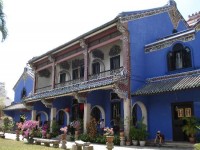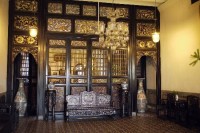Cheong Fatt Tze Mansion, Penang
A marvel of Chinese Feng Shui Architectural Elements
 This majestic mansion was built in the 1880s and belonged to the illustrious Cheong Fatt Tze. This is a traditional paradigm Chinese courtyard house with 38 rooms, it has superb Feng Shui. In the year 2000, this mansion won the “most excellent project” for the UNESCO Asia-Pacific Heritage Award for Culture Heritage Conservation. You can either stay in the 16 designer room or take a guided tour, which last about an hour to explore this majestic mansion, you will have the opportunity to view exquisite bedrooms, libraries, ceremonial halls, courtyards and gardens. Also displayed are rare porcelain, sculptures, carvings, tapestries, embroideries and antiques.
This majestic mansion was built in the 1880s and belonged to the illustrious Cheong Fatt Tze. This is a traditional paradigm Chinese courtyard house with 38 rooms, it has superb Feng Shui. In the year 2000, this mansion won the “most excellent project” for the UNESCO Asia-Pacific Heritage Award for Culture Heritage Conservation. You can either stay in the 16 designer room or take a guided tour, which last about an hour to explore this majestic mansion, you will have the opportunity to view exquisite bedrooms, libraries, ceremonial halls, courtyards and gardens. Also displayed are rare porcelain, sculptures, carvings, tapestries, embroideries and antiques.
It is reported that Cheong Fatt Tze actually has other mansions in other countries, such as Singapore, Hong Kong, China and Indonesia, but this one in Penang, is the most elaborate and lavish compare to the others, and even his native home in Tai’pu, China. This is said that there are only two such buildings of its size outside China.
The Mansion’s construction began before the end of the 19th Century, and it was said that Cheong Fatt Tze had hoped to house nine generations of his descendants there. The plot of land was chosen after heavy consultation with the era’s preeminent feng shui masters. Artisans were shipped in from Southern China expressly for the project, and building materials were imported from as far away as Scotland.
Towards Cheong Fatt Tze’s later life, No. 14 served as both an office and a home. It acted as the base for his commercial enterprises and housed the Chinese Vice-Consulate – not to mention his favoured 7th wife.
 All significant activities were concentrated in the centre of the mansion, with front halls allocated for business meetings, the administration of the Vice-Consul Generalship and formal greeting of guests. The rear halls were for ancestral prayers, dining and family; while areas on the first floor housed rooms for significant family members. It was understood that preferred family members were housed in the Centre Bay, while those who had lost favour, as well as lesser relatives, were moved to the wings.
All significant activities were concentrated in the centre of the mansion, with front halls allocated for business meetings, the administration of the Vice-Consul Generalship and formal greeting of guests. The rear halls were for ancestral prayers, dining and family; while areas on the first floor housed rooms for significant family members. It was understood that preferred family members were housed in the Centre Bay, while those who had lost favour, as well as lesser relatives, were moved to the wings.
Profile of Cheong Fatt Tze
Cheong Fatt Tze’s almost burdensome treasure trove of occupational hats – financier, tycoon, diplomat, politician, philanthropist and minister – not to mention his numerous, calling-card cramping unofficial monikers – ‘Rockefeller of the East’, ‘J.P Morgan of China’ and ‘Last Mandarin & First Capitalist of China’ – belie his decidedly unencumbered beginnings.
As a 16 year-old Hakka in 1856, Cheong followed the route of many Chinese fortune seekers, heading to the Southeast Asian region known as Nanyang, or ‘Land of Opportunity’. Penniless, armed only with determination and a driving need to prove himself, Cheong struggled through sheer hard work and enterprise to epitomize the typical rags-to-riches story. Rising from being a ‘bearer of river water’ in his early years to a ‘one-man multinational conglomerate’, Cheong’s ascent was aided by a merchant father-in-law who perceived potential in the young man, whom he helped establish in the business world.
Captain Of Captains Of Industry
Throwing himself headlong into the world of business and finance, Cheong Fatt Tze invested in banks, glassworks, cattle and textiles – almost all of which proved to be lucrative ventures. As his empire grew, he began operating steamships, eventually inaugurating a trans-Pacific shipping line between China and the United States. His was certainly a success story of which legends are made.
And the legend could certainly afford to ‘toast’ his tremendous successes, as, after developing a passion for European wines, Cheong Fatt Tze went on to establish his very own winery in 1892. Founded in China’s Shantung province, Chang Yu Winery specialized in producing the very Western wines Cheong Fatt Tze adored. Still in operation today, the winery supplies up to 25% of all Western wines consumed in the founder’s homeland, making it the county’s most successful Western wine producer. A virtual household name, Chang Yu Winery also produces popular brands of Chinese herbal wines.
Though a voracious globetrotter, Cheong Fatt Tze was still very much a nationalist at heart – as demonstrated by chairing of the Nanyang movement to China – which helped in the establishment of modern banks, to the realization of capital for funding railroads and technical institutions in his motherland. His efforts were recognized by the Manchu Empress Dowager, who promoted him to Mandarin of the Highest Order and Special Trade Commissioner for Southeast Asia.
In 1896, he established several Chinese banks before returning to China to handle the ministry of Commerce, as well as the railway services of the country. In 1901, Cheong was promoted to Deputy Minister, rising to be a full minister a year later. In 1911, he became a senator in parliament and advised the Chinese government on administrative and trade matters.
Candid Cheong
Displaying an apparent comfortable ease in both Asian traditions and the Western world, Cheong Fatt Tze surrounded himself with manifestation of his success. Splendid mansions were dotted around Asia – along with (8 officially acknowledged) wives, concubines and hand-maidens to meet his needs. The number of children he fathered during his lifetime is unclear, though he officially acknowledged 8 sons and 6 daughters.
He died of pneumonia in Jakarta on September 11th, 1916 – an event which occasioned the British and Dutch authorities to order the lowering of flags to half-mast.
[tb_google_map]